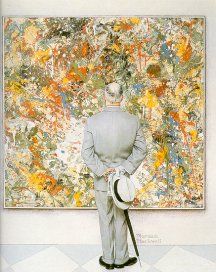Bill’s Trip to Canada’s National Capital: Part II
I stayed in Ottawa recently to take a course in Oracle, the world’s most powerful and expensive data base. I stayed at the Lord Elgin, which is really pretty fancy, though I assure you it is priced very competitively with Holiday Inn. They took my car away from me from the moment arrived– I haven’t even seen my keys in four days– so I was forced to walk everywhere.
I walked down the Rideau looking for a Wendy’s. There were two Burger King’s, a McDonald’s, a Dairy Queen, and a food court in the Rideau Centre, a giant shopping mall. I ended up with a Mozza burger from A&W and New Yorker Fries and a complete waste of dinner.
On the way back, I stopped in at Chapters to try to find a book on humor by Gershon Legman. The staff were not helpful. Well, I’d never heard of him either until recently. The computers they have scattered throughout the store are supposed to help you find books. It found Legman’s book but it declared that not only was it not in stock, but it wasn’t even “available”. This is a book that some people with opinions I respect think is a very, very important book.
On the way back, I dropped into the Canadian Museum of Contemporary Photography. There is a long staircase descending from Rideau St. to a long, empty hall, and then another staircase that descends to the main hall. On the upper hall is a display of photographs of images from a television set of an 8mm camcorder video taken by a guy named Ho Tam. In these images, Ho “moves between the roles of observer and participant” and produces a series of “grainy yet sensitive pictures”. Ho reflects on his schooling experiences (the shots are taken in a Catholic school he attended in Hong Kong) and, “most importantly, the ‘lessons’ learned during those formative years— love, desire, discipline, trust, fear, and loss of innocence”.
To me, they looked like a bunch of badly lit, badly aimed Kodak Instamatic photographs. What’s in them? What did you think would be in them, given the description above– “loss of innocence”? They consist of a bunch of images of the buildings, the kids playing soccer or hanging around, and the toilets, and foliage.
Well, that’s the problem with modern art, you know. I say I wanted to see some very sharp, specific images of faces and people acting upon each other and their environments. The artist asserts that I am oppressing him with a paternalistic and fascist sense of structured literalistic meaning.
But let’s think about this. Why do we have modern art? Because artists since 1920 have been so wildly inventive and imaginative that they have single-handedly struck upon a mode of expression that contains the unparalleled potential to illuminate the zeitgeist of our own era? No. Modern Art exists because photography came along and removed the figurative, representational purpose of painting and sculpture. With nothing else to do, art turned in upon itself and became self-referential, drawing attention to it’s methods and material elements and structure. The next thing you know, it is mocking those very self-referential elements, and then it is trying to draw attention to the fact that it is mocking itself, and then it tries to be so cool that it doesn’t even seem to be mocking itself, all the while demanding that patrons pay outrageous sums of money in order to exhibit these products upside down in their living rooms.
So you have Jackson Pollock with his splatter-paintings, and Andy Warhol with his soup cans. So you have the Metropolitan Museum of Modern Art in New York fighting bravely for the honor and respect of modern art now caught in it’s own theological disputes over whether or not post-modernism really exists and should have a place to display itself.
And you have Ho with his deconstructed photographs. What is he doing?
He is using a technology to imitate an art form that is a revolt against his technology.
Is he a genius?
No, because he doesn’t understand what he is doing. What he thinks he is doing is making his photographs “artistic”. How do you make them artistic? Well, good heavens, not by finding interesting subjects and photographing them accurately. You make them artistic by finding uninteresting subjects and photographing them in uninteresting ways, with uninteresting angles, in degraded colour and low resolution, and then you mount them on the wall and point to them and tell people–you have to tell them, or they won’t know– that this is art.
Your artlessness camouflages the fact that you have no creativity to offer, that you didn’t do the hard work of composition, lighting, camera angle, colouration, and so on.
Most importantly, you ban cameras from the building.
I’m not kidding. I’m looking at these awful illustrations on the wall and reading a sign and the sign says that anyone trying to steal these images will be prosecuted for copyright violation. God help us, someone might try to steal a photograph of your bad photographs! It makes me think of an old, fat, diseased whore: “Don’t you even think of trying to get me to pose nude for you, my boy!”
Down the hall, in the main hall, don’t you know, are more mature works by a more respected visual artist– Pierre Boogaerts.
I am reading the program notes on Pierre Boogaerts. Is there any greater testimony to the bankruptcy of modern art than phrases like this: “… belongs to the generation of artist who adopted photography as their preferred means of expression in the early 1970’s”. Isn’t that bizarre? It sounds like elevator conversation– you have to say something, so say something inane. Anyway, his work is “marked by a conjunction of influences from Pop Art, Land Art, and conceptual art, and called into question the formulation and function of the work of art itself”.
That kind of consummate gobbledygook may have been excusable once upon a time, when the philistines were upon us, or when Stravinsky almost started a riot in Paris with “Rites of Spring”, but to write that kind of crap in 2001 of a mediocre artist like Boogaerts raises the question of whether the curators of this museum themselves must realize that it sounds like a joke.
There’s more:
“The Exhibition is selected from the entire body of work donated to the CMCP by Boogaerts in 1994. Poetry, an essential dimension of Boogaerts’ production, which is frequently masked by its conceptual art trappings, is highlighted in the structure of the exhibition through the use of analogy. This approach focuses attention on the visual beauty and associative processes inherent in the medium, which influenced the development of the artist’s ideas.”
Maybe you can rationalize away the word “entire”, as if he had another body of work that wasn’t “entire”, or the coy link to poetry, and maybe even “conceptual art trappings”, but I defy any sane person to excuse, in the name of literacy, “associative processes inherent in the medium”.
If you’re still interested, his photographs consist mainly of repetitious shots of leaves and buildings, arranged in various uninteresting collages or shapes and sizes.
I was the only person in the museum for the first ten minutes of my tour. Four or five other people came in while I was there. The staff, three people, well-dressed, behind the main counter, seemed discernibly alarmed when I came in. A security guard tried to follow me but I think she didn’t want to appear to be too suspicious so she hung back and tried to look nonchalant while making sure I didn’t stick a photograph of a leaf under my coat. They didn’t check me for anthrax or bombs or anything– does Osama Bin Laden know that the Canadian Museum of Contemporary Photography is a sitting duck?
It reminded me of a moment in Europe, in 1977. I toured the Rijksmuseum in Amsterdam, which was great, and very busy, and the Van Gogh Museum, also in Amsterdam, and the Louvre in Paris. At either of the latter two, I could easily have walked out with any painting, including the Mona Lisa. Shortly afterwards, a mad Dutchman sliced Rembrandt’s “The Night Watch” and that was the end of that era.
Everybody jaywalks in Ottawa, even the police. Well, perhaps I exaggerate. I didn’t actually see any police jaywalk, but I saw several of them sitting in cars or Jeep Cherokees near busy intersections and not one of them tried to arrest me for jaywalking.
Being the law-abiding sort, I wanted to wait for the lights to change, but this young girl who looked like she knew what she was doing blustered ahead of me and charged through the red “Don’t Walk Sign” so I followed. In fact, she demonstrated a convincingly degree of leadership, so I followed her for several blocks, at a discrete distance of course. She was good at it. She knew exactly when you could charge safely through a red stop sign and when it might not be safe.
We passed a demonstration near the National Arts Centre. I didn’t notice what it was for. I was instantly sympathetic with their cause…. until they started chanting. That’s when I am forced to tell myself that I could never be one with the poor and oppressed of this earth. I am genetically programmed to become nauseated at the first sound of a sing-along, group chant, slogans, and such. I would be a lousy demonstrator. When the woman with the bullhorn demands, “what are we going to do about it?”, I would shout, “I don’t know. What? Can we think about it?”
There was some kind of diplomatic gathering at Hotel Laurier. There were about twenty limos there with various chauffeurs standing around, shaking hands and gabbing. It looked like a United Nations get acquainted party. The cars, each with a distinctive red license plate, were parked all over the place, including on the sidewalks. I noticed that some of the “limos”, probably from poor third-world countries, were Neons and Jettas.
I saw something on the sidewalk and picked it up. It was some kind of identity card, which must belong to someone important. This person is so important, he doesn’t need his name or any other identifying marks on his card. It just has a magnetic stripe., and it is attached to some kind of belt clip with a yoyo type wire that reels back into a little disc. Very cool. I looked around at the chauffeur drivers but none of them met my eyes, so I walked off down the street with it. A few blocks later, I passed a cop and thought of turning it over to him, but then I thought it might arouse suspicion in these paranoid times, so I tucked it into my pocket and walked back to my hotel.


 painting.
painting.